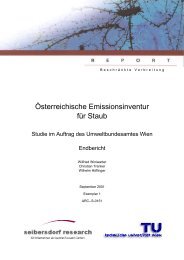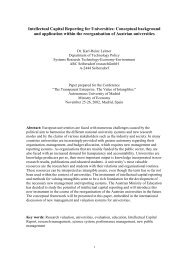ALPMON FINAL REPORT - ARC systems research
ALPMON FINAL REPORT - ARC systems research
ALPMON FINAL REPORT - ARC systems research
Create successful ePaper yourself
Turn your PDF publications into a flip-book with our unique Google optimized e-Paper software.
Contract ENV4-CT96-0359 <strong>ALPMON</strong><br />
� Sealed surfaces cannot be separated from rock, gravel, and soil based only on the spectral<br />
characteristics of these classes, as the spectral signatures are too similar. Additional information<br />
has to be introduced to classify this category with higher accuracy, or the information must be<br />
taken from GIS data.<br />
On the other hand, most categories required by the customers could be classified with sufficient<br />
accuracy. In general no problems occurred with the classification of the forest type in those areas,<br />
where pure coniferous or broad-leaved stands are common. Forest age could be classified at least in<br />
some test sites, where pure age stands occur. In the Dachstein test site it was possible to separate<br />
pure larch stands from spruce and other coniferous stands. In the Dachstein and Mangfall test sites<br />
even dwarf mountain pine could be classified by means of winter satellite data. Furthermore, some<br />
classes could be divided into subclasses (e.g. pasture and meadow, carbonate and silicate rocks)<br />
giving more detailed information. Problems with the classification of water bodies or sealed surfaces<br />
could be overcome by introducing auxiliary data into the classification process. In general, it can be<br />
stated that the outcome of classification was satisfactory with respect to the local as well as the<br />
European wide applications.<br />
3.3.8 Data integration into <strong>ALPMON</strong><br />
The integration of data into <strong>ALPMON</strong> worked well due to the efforts made in WP3. Nevertheless the<br />
database for storage of the parameters of the training areas was not used by all partners because<br />
some partners already had established extensive data bases for their test sites. As these included<br />
additional, test site specific parameters, it was not possible to include these data into the MSAccess<br />
data base.<br />
3.3.9 Feasibility studies<br />
3.3.9.1 Tourism<br />
For the tourism application the fusion image has been of central importance. The known methods like<br />
Brovey- and IHS transformation give a possibility to fuse images, but they are not able to dissolve the<br />
pixels from the multi-spectral image. So the result is an image with the higher resolution of the<br />
panchromatic image and much bigger coloured tiles of the multi-spectral scene. For visualisation tasks<br />
this kind of image is not always satisfactory.<br />
The AIF method of STEINOCHER (1999) has been a very good pre-processing to the mentioned<br />
transformations. Visually the colour information of the multi-spectral scene is fitted to the objects of the<br />
panchromatic scene. This fact is decisive for the visual impression of an image. The fusion image is<br />
the background image of the tourism information system that has been developed during <strong>ALPMON</strong>.<br />
The tourist is able to zoom into the image, therefore the resolution is of importance. The AIF method<br />
allows to give the tourist the impression that he looks at a normal colour aerial photograph.<br />
The tourist information system has been developed to give some ideas and possibilities to the local<br />
administrations. It has been shown how GIS technology could be used for more than analysis. A hiker<br />
information system has been programmed. Such an information system can be used in a variety of<br />
ways and places: It can of course be made available at the Tourist Office in the region itself; it could be<br />
used via Internet or in travel agencies. The presentation in the Internet or travel agency would demand<br />
different software. These would have to be "stand alone" solutions because it would be too expensive<br />
to bye the GIS software for every travel agency.<br />
For the monitoring of landscape changes visual interpretation has been necessary, because aerial<br />
photos from 1954 and the fusion image of 1992 have been compared. In the future classification<br />
results could be used instead of visual interpretation. But for monitoring alpine pastures high resolution<br />
multi-spectral scenes are demanded.<br />
The classification results have been used for several purposes. It could be shown that classification<br />
results are not only of interest for landscape related administrations but also for the hiking tourist. But<br />
there has been the problem that the classification of shaded areas has not been succeeded. So for the<br />
shaded part of the test site no classification information could be gained.<br />
JR, RSDE, ALU, LMU, Seibersdorf, WSL 80




